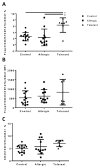Naturally occurring tolerance acquisition to foods in previously allergic children is characterized by antigen specificity and associated with increased subsets of regulatory T cells
- PMID: 25989379
- PMCID: PMC4607624
- DOI: 10.1111/cea.12570
Naturally occurring tolerance acquisition to foods in previously allergic children is characterized by antigen specificity and associated with increased subsets of regulatory T cells
Abstract
Background: Food allergy affects approximately 6-8% of children, and increasing in prevalence. Some children naturally outgrow their food allergy without intervention, but the mechanisms by which this occurs remain poorly understood. We sought to investigate the role of regulatory T cells in the development of naturally acquired tolerance.
Methods: Fifty-eight children (1-18 years) with either egg or peanut allergy, recent acquisition of natural tolerance to egg or peanut, or no food allergy were studied. Peripheral blood mononuclear cells (PBMC) from these groups were stimulated with relevant antigen for 48 h and flow cytometry performed to characterize both surface (CD3, CD4, CD25, CD14, CD19, and CD127) and intracellular markers (IL-10, Foxp3, and IL-5).
Results: Resting PBMC from naturally tolerant patients had significantly increased CD3+CD4+CD25+CD127loFoxp3+ cells, when compared to allergic or control patients (mean 6.36 vs. 2.37 vs. 2.62%, respectively, P < 0.05). Upon stimulation with relevant antigen, naturally tolerant patients also had increased IL-10-expressing CD25+CD127lo cells (6.33 vs. 1.65 vs. 0.7, P < 0.01), Foxp3+ cells (mean 12.6 vs. 5.42 vs. 3%, P < 0.01), and CD4+ cells (mean 4.48 vs. 1.59 vs. 0.87%, P < 0.01); the increase was not observed in PBMCs from allergic or control patients. Additionally, this upregulation was only seen with relevant antigen stimulation and not upon stimulation with unrelated antigen.
Conclusion: The increased CD3+CD4+CD25+CD127lo cells at baseline and upon stimulation and increased induction of IL-10-producing cells of several types, including Tr1 cells, from naturally tolerant patients suggests an important role for regulatory T cell subsets in the acquisition of natural tolerance.
Keywords: IL-10; T regulatory cells; antigen specificity; food allergy; natural tolerance.
© 2015 John Wiley & Sons Ltd.
Conflict of interest statement
Conflicts of Interest: All authors report no affiliations or financial interest in the subject matter or materials discussed in the manuscript.
Figures




Comment in
-
What makes children outgrow food allergy?Clin Exp Allergy. 2015 Nov;45(11):1618-20. doi: 10.1111/cea.12592. Clin Exp Allergy. 2015. PMID: 26467648 No abstract available.
References
-
- Sicherer SH, Sampson HA. Food allergy: Epidemiology, pathogenesis, diagnosis, and treatment. J Allergy Clin Immunol. 2014;133(2):291–307. quiz 308. - PubMed
-
- Kumar S, et al. Molecular mechanisms of IgE mediated food allergy. Int Immunopharmacol. 2012;13(4):432–9. - PubMed
-
- Berin MC. Mechanisms of allergic sensitization to foods: bypassing immune tolerance pathways. Immunol Allergy Clin North Am. 2012;32(1):1–10. - PubMed
-
- Vissers JL, et al. Allergen immunotherapy induces a suppressive memory response mediated by IL-10 in a mouse asthma model. J Allergy Clin Immunol. 2004;113(6):1204–10. - PubMed
Publication types
MeSH terms
Substances
Grants and funding
LinkOut - more resources
Full Text Sources
Other Literature Sources
Medical
Research Materials

